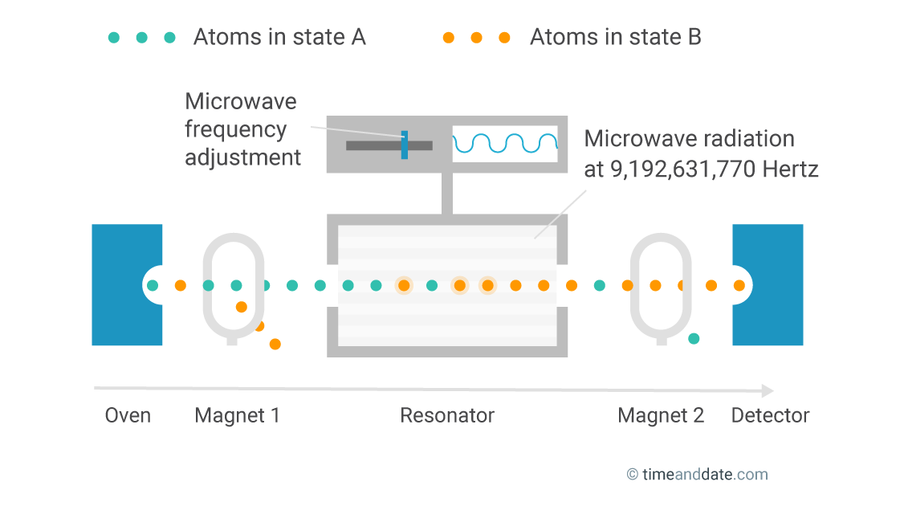Atomic Clock | 13 Jun 2024
Why in News?
In a recent study published in the scientific journal Nature, a new type of portable Optical atomic clock was introduced for use on ships.
- This new iodine clock is not as precise as an optical atomic clock used in a laboratory but it is more portable and durable. It gains or loses a second every 9.1 million years.
What are Atomic Clocks?
- About:
- It is an advanced timekeeping device that utilises the natural vibrations of atoms to measure time with exceptional accuracy.
- It was developed by Louise Essen in 1955. Presently, India has operational atomic clocks located in Ahmedabad and Faridabad.
- Key Features:
- Atomic clocks are far more precise than conventional clocks because atomic oscillations have a much higher frequency and are much more stable.
- Atomic clocks are very accurate, with traditional atomic clocks losing or gaining one second over 300 million years, while optical atomic clocks can maintain this precision for 300 billion years.
- A caesium atomic clock loses or gains a second every 1.4 million years.
- Working:
- Caesium (Cs) atomic clocks operate by causing Cs atoms to transition to a higher energy level, which is linked to the frequency of microwave radiation and the measurement of time in seconds.
- In this process, Cs atoms are placed in a cavity, and microwave radiation with a specific frequency is directed towards them. When the frequency of the radiation matches the energy transition of the Cs atoms, it creates a resonance phenomenon. The Cs atoms absorb this radiation and move to a higher energy state. This transition occurs precisely when the frequency of the radiation is 9,192,631,770 Hz.
- This means that when a Cs-133 atom undergoes 9,192,631,770 oscillations between its energy levels, one second has elapsed.
- The precision of atomic clocks is achieved through a system that detects any deviations in the resonance frequency and makes adjustments to the microwave radiation to maintain resonance.
- Optical Atomic Clock:
- They are even more accurate than Atomic Clocks.
- These clocks use lasers to stimulate atomic transitions, producing highly coherent light where all emitted light waves have the same frequency and stable wavelengths.
- It is different from Atomic Clock due to:
- Higher Operating Frequency: Optical atomic clocks operate at higher frequencies, allowing them to complete more oscillations in a given time frame compared to traditional atomic clocks.
- This enables them to measure smaller increments of time more accurately due to the increased number of cycles counted within that time period.
- Narrower linewidth: These have much narrower linewidths (range of frequencies) over which the atomic transition occurs. A narrower linewidth makes it easier to precisely tune the frequency of the optical light that triggers the resonance, leading to higher accuracy and more precise time measurements.
- Higher Operating Frequency: Optical atomic clocks operate at higher frequencies, allowing them to complete more oscillations in a given time frame compared to traditional atomic clocks.
- The element strontium (Sr) is commonly used in optical atomic clocks due to its narrow linewidths and stable optical transitions.
What are the Applications of Optical Atomic Clocks?
- Self-Reliance and National Security: India's reliance on foreign atomic clocks, especially those from the US, poses a risk to critical infrastructure like NavIC (Indian GPS) in times of conflict.
- Creating domestic atomic clocks will provide independent timekeeping, enhancing national security.
- Enhanced Accuracy and Reliability: Atomic clocks offer unmatched precision compared to conventional methods. By deploying them across the nation, India can synchronise all digital devices with Indian Standard Time (IST), ensuring a unified and highly accurate time reference.
- Time synchronisation through optical atomic clocks will benefit various sectors:
- Telecommunications: Precise timing minimises errors and facilitates seamless data transfer in communication networks.
- Financial Systems: Accurate timestamps for financial transactions safeguard against fraud, especially in high-frequency trading.
- Cybersecurity: Atomic clocks play a crucial role in India's digital economy by ensuring the accuracy of timestamps for transactions, which helps prevent fraud, maintain data integrity, and enhance cybersecurity measures.
- Critical Infrastructure and Power Grids: Atomic clocks play a vital role in synchronising critical infrastructure, including power grids, transportation systems, and emergency services.
UPSC Civil Services Examination, Previous Year Question (PYQ)
Prelims:
Q.1 Which one of the following countries has its own Satellite Navigation System? (2023)
a. Australia
b. Canada
c. Israel
d. Japan
Ans: d

